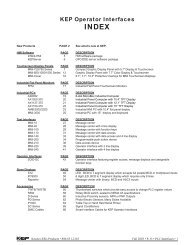Safety Guide copy - Meltric
Safety Guide copy - Meltric
Safety Guide copy - Meltric
- No tags were found...
Create successful ePaper yourself
Turn your PDF publications into a flip-book with our unique Google optimized e-Paper software.
Key Elementsof NFPA 70EThe Standard for Electrical<strong>Safety</strong> in the WorkplaceAs the foremost consensus standard for electrical safety in the workplace, NFPA70E is the primary resource for employers to use in determining how to complywith OSHA’s electrical safety regulations. It is also used by OSHA and the courts inthe investigation of injuries in order to assess whether or not the involved employerstook reasonable steps and precautions to protect their employees.The key elements of the standard are summarized below. Complete details shouldbe obtained from the standard itself. In Canada, CSA recently published CSA Z462‘Workplace Electrical <strong>Safety</strong>’ which is based on and is harmonized with NFPA 70E.Key elements in CSA Z462 are essentially the same as those found in NFPA 70E.Article 110General Requirements for Electrical<strong>Safety</strong>–Related Work PracticesTraining Requirements (110.6)Employees who may be exposed to electrical hazards must be specifically trained tounderstand the hazards associated with electrical energy as well as the safety-relatedwork practices and procedures required to provide protection from them. The levelof training provided determines the tasks that an employee is qualified to perform.Only specially ‘Qualified Persons’ may perform work on or near exposed and energizedelectrical conductors or circuit parts. The training requirements include:National Electric CodeSection 110.16 Flash ProtectionFPN No. 1:NFPA 70E-2004, Electrical <strong>Safety</strong> in theWorkplace, provides assistance in determiningthe severity of potential exposure, planningsafe work practices, and selecting personalprotective equipment.▼ How to recognize the potential hazards that exist▼ How to distinguish energized from non-energized parts▼ How to determine the voltage of exposed energized electrica conductors▼ The relationship between the hazard and potential injury▼ How to avoid exposure to the hazards▼ How to select appropriate personal protective equipment▼ Specific work practices and procedures to be followed▼ Emergency procedures for assisting victims of electrical incidents▼ How to perform a hazard/risk analysis▼ How to determine approach and flash protection boundariesElectrical <strong>Safety</strong> Program (110.7)Employers are required to implement and document an electrical safety program todirect employee activities in a manner that is appropriate for the different voltage,energy level and circuit conditions that may be encountered. This safety programshall include all electrical safety procedures, be documented in writing, and bemade available to all employees. If work on or near energized electrical conductorsand circuit parts operating at 50V or more is required, the safety program must:4
















